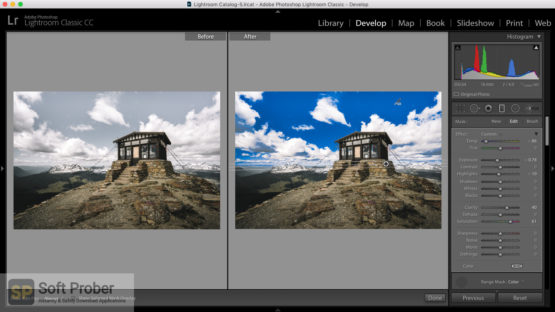
- #How to view full screen adobe lightroom cc 2015 how to
- #How to view full screen adobe lightroom cc 2015 full
- #How to view full screen adobe lightroom cc 2015 professional
- #How to view full screen adobe lightroom cc 2015 download
- #How to view full screen adobe lightroom cc 2015 free
#How to view full screen adobe lightroom cc 2015 download
Simply click the download link, unzip the the file and copy the LRInstagram.lrplugin file to your Lightroom plug-ins folder. It’s called LR/Instagram and you can download it HERE They’ve made a Lightroom Instagram Plugin – and it works! Needless to say I put Instagram on the back-burner.īUT……………….someone has done something EPIC. I tried a couple of programmes that were supposed to help put images on Instagram from a desktop machine, but they turned out to be more bloody complicated than the iPad method. I put a single image on there – it took me at least 30 minutes, and Rich was pissing himself laughing which didn’t help! So here I am looking at Instagram and seeing that I have to send an image to my iPad then I can upload it to Instagram – WTF?
#How to view full screen adobe lightroom cc 2015 how to
I have an iPhone and an iPad but bare in mind it took me ages to work out how to put pictures on them.Īnd ALL mobile apps confound the hell out of me – so overly-simplified I find them difficult to use and I run out of patience! “It’s simple Dad, it’s Twitter for images”……….I couldn’t work out who to shoot first, me or him.īut, after much grief I was eventually shown how to put an image on Instagram.
#How to view full screen adobe lightroom cc 2015 professional
Over the last year I’ve also been aware of the growing use by professional of this other “thing” called Instagram.Ībout two months ago I asked my son Richard to explain how it works:
#How to view full screen adobe lightroom cc 2015 free
Patrons gain access to a variety of FREE rewards, discounts and bonuses.Įven though I suppose I am rather tech-savvy for an old fart, I have major head-problems with most social media.įacebook took me years to get the hang of.Īnd even though I have an account, followers and everything I simply CANNOT get my head around Twitter ….
#How to view full screen adobe lightroom cc 2015 full
I hope you find this post useful folks, and don’t forget to watch the video at full resolution on my YouTube Channel.īecome a patron from as little as $1 per month, and help me produce more free content. Typically the Lightroom tonal curve range for midtones is 25% to 75%, but Lightroom is quite happy to accept a midtone range of 10% to 90% – check those midtone arrow adjusters at the bottom edge of the parametric tone curve! It’s also a detail killer, because 99% of the subject detail is in the mid tone range. This is a dynamic range visualisation killer because it crushes the ends of the midtone range. Lightroom typically ADDS a medium contrast tone curve but ‘calls it’ LINEAR.īoth of this are contrast INCREASES, and any increase in contrast can be seen as a ‘compression’ of the tonal space between BLACK and WHITE.Lightroom typically ADDS a +33 contrast adjustment but ‘calls it’ ZERO.We are simply reducing the EXCESSIVE CONTRAST that Lightroom ADDS to our files. We are NOT really reducing the contrast of the raw file we captured. Why is contrast control important, and why does it ‘add’ so much to my images Andy?

Now that you’ve got good contrast control you can set about processing your image – just leave the contrast slider well alone! Lens Corrections Panel: Tick Remove Chromatic Aberration.

Details Panel: Reset Colour Noise to default +25ĩ. Details Panel: Reset Sharpening to default +25Ĩ. Basics Panel: Adjust Black Setting to taste if needed.ħ. Basics Panel: Double Click Exposure (goes from -1 to 0)Ħ. Camera Calibration Panel: Choose Process Version 2012ĥ. Camera Calibration Panel: Choose Process Version 2010Ĥ. Camera Calibration Panel: Choose CAMERA NEUTRALģ. Here is a step-by-step guide to the various Lightroom actions you need to take in order to obtain good contrast control:Ģ. The process might seem a little tedious at first, but it’s really easy when you get used to it, and it works on ALL images from ALL cameras. This video is best viewed on my YouTube channel: It involves the use of the ‘zero’ preset together with a straight process version swap around, as illustrated in the before/after shot above and in the video linked below. But as Lightroom CC 2015 evolves, trying to ‘nail’ the best way of doing something becomes like trying to hit a moving target.įor the last few months I’ve been using this (for me) new method – and to be honest it works like a charm! I have posted on this subject before, under the guise of neutralising Lightrooms ‘hidden background adjustments’.

It allows you to reveal more of your camera sensors dynamic range.Learning how to deploy proper contrast control in Lightroom brings with it two major benefits:


 0 kommentar(er)
0 kommentar(er)
